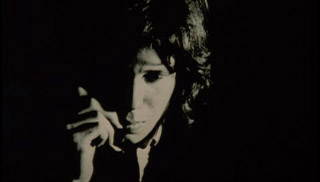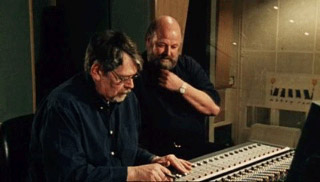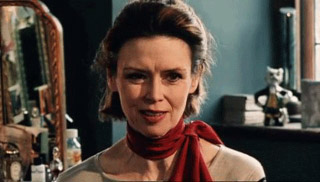| |
"If you met a girl and took her back to her room and if there were some Nick Drake records there, you were probably going to want to marry her..." |
| |
Introductory voice over on A Skin Too Few (voice not identified) |
One person's cool is another's acid splashed mortification. People judge cool in very many different ways. There are few cross cultural, cross-class and cross-generation accepted benchmarks. Maybe the colour black, but that's it. My eleven year old's definition encompasses hi-tech gadgets, Nintendo's Zelda and a friend of mine who liberally swears in front of him (so therefore he's cool) and gave him Zelda to play in the first place (so he's super-cool). There are friends whose good graces one courts for the selfish buzz of being recognised as part of their cooler-than-you-are club. Yes, there are other words for this condition; pathetically engorged, rank insecurity. But where and when you discover Nick Drake is also a curious and oddly satisfying 'cool' benchmark.

From silver spoon gummed to Cambridge and early professional obscurity to an alleged accidental suicide at 26 (Jesus, 26), Drake edged into the Zeitgeist in a different millennium, or rather he was given a lift in a Volkswagen of all things. To summarize: here was a recording artist that all who knew him loved him and his music. He cut three albums in the early 70s, sold about 14 copies and suffering from clinical depression, crawled back to his parent's house and died from a widely believed to be mistaken overdose. And then a Nick Drake aficionado working for an ad company, mixed the sublime 'Pink Moon' cue from Drake's third and final album of the same name to sell a bloody VW Cabrio in 2000. Bingo.
Mice twitched, Google was alerted and Amazon.com went "Huh?" (the album became the store's fifth best seller during the ad campaign) and within a single month, Drake had sold more albums than he had in the past thirty years. Suddenly (way too late for Drake himself, granted) the lanky, silken voiced poet started to get the recognition he'd worked so hard for during his short life. The Drake wave drenched me only a few years ago via a Radio 2 documentary hosted by none other than Drake fan Brad Pitt and a neighbour who owns many incarnations of Drake's albums and a gorgeous valve-based amplifier feeding from a turntable that takes two JCBs to relocate. Every music lover should find the same gear to really revel in the difference between analogue and digital. The future's not as future-proof as it used to be.
And Drake had a way of making his guitar sound smoothly enveloping (and so precise, like wood and cat gut harmonizing with perfect diction) and that voice, that gentle, vulnerable sound of a man whose life was buffeted by forces outside his control – that or by a deeply misjudged petulance at not being as famous as friends and recording colleagues said he should be. Let's face it. Drake was an over-privileged, bright boy whose desire 'to help just one person' through his music was short circuited by circumstances which left him a hopelessly incapable manic-depressive. One could be uncharitable (I mean this guy was really privileged) but in the end I tend to react to the work (lies! You may try to, old man...) and attempt and keep the artist out of it. And the work, is sublime. To do that sublimity justice, you need a sympathetic and talented film-maker confident and comfortable enough with his/her own voice.

Director Jeroen Berkvens gained access to Drake's family, pre-recorded parental reminiscences and home movies. He recreated Drake's bedroom in a studio to have complete control over his images and uniformly, the images are both sumptuous and undeniably cemented in the 70s. He must have used 70s glass to shoot through. The grading screams period and the density and softness of the images are a direct anti-MTV statement, a way to forge a visual identity to songs that are almost too personal to anchor images too. But Berkvens does a superb job at cinematic hypnotism. To someone weaned on MTV meta-cut sound and fury, the images (and of course Drake's music) hold you in thrall.
These autumnal wide, high crane shots will not to be everyone's taste (I'm biased as I live in a place very much like the images featured, lucky me) but Drake's popularity and work almost demands this kind of directorial rigour. The music has a literal voice. The movie had to have a guiding voice. And it's enormously affecting. I can imagine the editor begging to cut some of these shots shorter. I'm so glad he/she didn't (the name of the editor is Stefan Kamp, probably male). It takes some guts to present images like this in the 21st century and all power to the film-makers for doing just that. Never have I seen shots lasting this long appearing to be radical. The times we live in...
The documentary follows Drake's all too short life in a linear chronology. To underline the literal wealth of his background, we start in Burma where the Drakes lived like kings in the 40s. Taking us through this colonial back-story is a woman who was a small (but perfectly formed) part of my own adolescence. Nick Drake's sister, Gabrielle, was the tall, purple wigged commander of SHADO's Moonbase in Gerry Anderson's UFO. Her and her body parts were featured heavily in the show's opening sequence. There's a good reason for this. This was woman incarnate; an hourglass figure, long legs, a sweet face and a cut glass accent (not sure how sexy I judged the latter to be in the mid-70s but you get the point).
Her contribution to this documentary is important as it gives the film some authorised and personal weight. The film is about Drake's days, the contribution of the world that made him, in effect his life not his work even though the two are pretty much inseparable. For an examination of Drake's work and influence without family contributions, I point you in the direction of the DVD Nick Drake Under Review which ironically I won't be reviewing unless it knocks my socks as clean off as this one did. Gabrielle's memories are powerful framing devices and give her brother's life a very real immediacy. It's a testament to the point of view of the documentary's director, Berkvens, that we are not completely sold on Nick Drake as tortured artist ahead of his time. His background seemed to have given him no armoury of defensive shielding for the abrasions the world was bound to foist on him.

Like Arthur Rimbaud (the French poet, not Sylvester Stallone's steroidal nut-job despite the similarity in pronunciation), the romantic notion of Drake giving up because his art was not fully embraced in his own time is teetering on the abyss of mega-cliché but, Jesus. In this case it just might be true. Rimbaud lost all interest in his writing at twenty-one and despite what my French teacher told me what seems like a millennia ago, he did not kill himself because his public failed to appreciate his genius. Perhaps Nick Drake did just that.
The feature is presented in anamorphic 16:9 and as stated, a lot of work has gone into making the 35mm look as if it just stepped out of the 70s (I'm assuming the IMDB info is correct as regards the stock). The nature photography is bold and colourful (even if that colour is autumnal brown) and there is not a lot of noticeable dirt. I must admit to seeing no major blemishes that jumped out during viewing. The blacks are deep and the contrast is way up (that's a good thing) even in the interviews. Gabrielle Drake looks harshly lit (it's just the gamma being tweaked to make her match everything else) but it's all in keeping with the mood of the piece. It comes in at just under 48 minutes (47:51) and those minutes fly by. It's hypnotic in a good way.
The Dolby 5.1 soundtrack deserves a mention. I don't know if Berkvens had access to master tapes (obviously he did during a scene in a recording studio where they isolate the tracks – haunting to hear Drake's voice singled out. It feels naked without the guitar) but the film's sound is gorgeous and all encompassing. The subwoofer takes care of the renowned Drake bass lines but the music sounds better on this film than my album recordings sound off my iTunes (and no, that's not because they are mp3s. I'm an AIFF man). A lot of work has gone into this soundtrack and it's to be commended. There are no subtitles or hearing impaired tracks.
Uh... The spirit of Nick Drake in DVD menu photo form? Not really. In short, nothing.
This is the bit where I confess you can't actually buy this DVD on its own yet. Sorry. No, it doesn't need a guardian to hold its hand. It's bundled as a freebie in The Fruit Tree box set – essentially Nick Drake's entire recording career minus a few tracks cobbled together after he died. Aficionados should go for the vinyl version (if they have a lead turntable and an amplifier that takes minutes to warm up) or the CD if they want to appear even more retro... As for a stand alone release... the director e-mailed me with the sad industry fact that "these decisions are made by Universal/ Island." If you're a Nick Drake fan, you already have the albums so is the DVD worth the price of the box set? Like most things, this depends on how much you can get it for. If you're curious and have never heard of this man, then splash out. You won't be sorry.
|